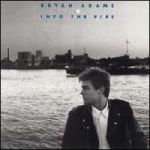Long Player: Bryan Adams / Into The Fire
Is Bryan Adams underrated with his legacy of loud rock and roll, filled with generic lyrics, cranking guitars, slamming drums, and hooks made of bubblegum? How has time treated the music of a guy who best took the Mellencamp/Springsteen template and covered it with a bunch of sugar? We look back at the album that came after his career-making Reckless record. Is Bryan Adams an overrated rocker, tainted by three or 12 too many vapid soundtrack songs? Or not? 
Here’s what I did. I slapped the 1987 Into The Fire album on the turntable (yep, the vinyl LP) and gave the volume knob a pretty good twist. It’s the album that followed Reckless, which ranks as one of the 10 best rock albums of the 80’s. (Argue if you want. “Summer of ’69?” “Run to You”? That shit sounded great coming out of the car radio. And the album tracks on it were just as good). The problem for Adams was by 1987, he had worked hard for the better part of ten years. This is the album that came from that place.
Into the Fire is a loud, excessive, indulgent record, with more 80’s reverb lacquered into grooves than necessary. But turned up, with a beer in hand (which is how Bryan Adams music should be consumed, right?), it was worth a loud listen to recalculate Adams at the time, and his place in 80’s (and after) rock and roll.
Side 1
Track 1 “Heat of the Night” was the first song sent to radio, so this was the first chance to hear him since the previous album’s smashing success. The sound is trademark Bryan Adams, but the song didn’t soar like the tunes on the previous record. A little leaden.
Track 2 “Into the Fire” – Everything said about track one applies here, and even more overwrought.
Track 3 “Victim of Love” is a forgotten power ballad that could be one of his best, nicely straddling a line of schmaltz and balls.
Track 4 “Another Day” is the first tune on side one that gets a little loose, and harkens back to the “Cuts Like Knife” era. The band goes nuts at the end before Bryan pulls them back together.
Track 5 “Native Son” sounds Canadian, in the tradition of the Tragically Hip and other 80’s and 90’s Canadian rock bands. (Remember Honeymoon Suite?) It’s one of two similarly-themed songs on the album, along with side two’s “Remembrance Day”. Bryan is shooting for an anthem, though didn’t quite make it. But dammit, the drums sound good.

This record echoes those snares on the U2/Alarm/Simple Minds albums that had a slammin’, gated reverb sound. So did Phil Collins, Springsteen, Prince and nearly every band that made rock records from 1983-1987. It resonates with a part of my soul that responds to that specific sound, in the midst of rootsy guitars and raspy vocals.
So, when Bryan lets “Native Son” die down, before kicking back in, it’s good. The record may have gotten too beaten up by critics. Hell, it still sold more than a million copies. It got radio play. But I remember disappointment after the hits of Reckless.
Side 2
Track 1 “Only the Strong Survive” is uptempo plodding, if that’s possible. Bryan again straining; it doesn’t connect.
Track 2 “Rebel” trying to replicate his “Heaven” ballad gene, and it proves to be a rewrite that sounds OK but no home run. Again, though, the drums sound good.
Track 3 “Remembrance Day” continues the anthem push. A bit of Canada namechecking seeps in, with Kingston and Brighton. The guitars panned left and right are killer, and the strings at the end work nicely. Adams’ voice – that whiskey Rod Stewart roar – is one of his gifts;
Track 4 “Hearts on Fire”, buried on side two, is the “Summer of 69” rewrite for the album and was actually written for the Reckless album. The cut is a blend of all that is good about Bryan Adams before Mutt Lange got to him and “Def Leppard-ed” his sound. With keyboards emulating a Hammond B3, and a start-stop chunking twin guitars from longtime band guitarist Keith Scott and Adams, the music pushes forward with the best energy on the record. And I hear cowbell too.
Track 5 “Home Again” tries too hard and ends the record with a thud.
Adams came back after this release with another couple records, teaming with producer Lange, and had hits with his post-Def Leppard, pre-Shania Twain recipe of sound. By the mid 90’s, Bryan was essentially musically spent. His later records work to varying degree to echo the classic sound but have never quite recaptured the mystery of what made him memorable.
So is where is Bryan Adams’ place in rock and roll? In the end, his music library holds up because it is tightly constructed rock and roll ear candy, done smartly. And it certainly sounds like American rock music. I listened to the whole record, and never wanted to turn it off. His four album run of Cuts Like A Knife, Reckless, Into The Fire and Waking Up The Neighbours was the peak of his career arc. Through this run, even the mediocre songs contain moments of rock band thrills and noise that make my dumb rock fan heart expand. I would argue there is great value in hearing music that penetrates to your musical soul, whether it stays forever or for just a few moments. Adams was able to do both.